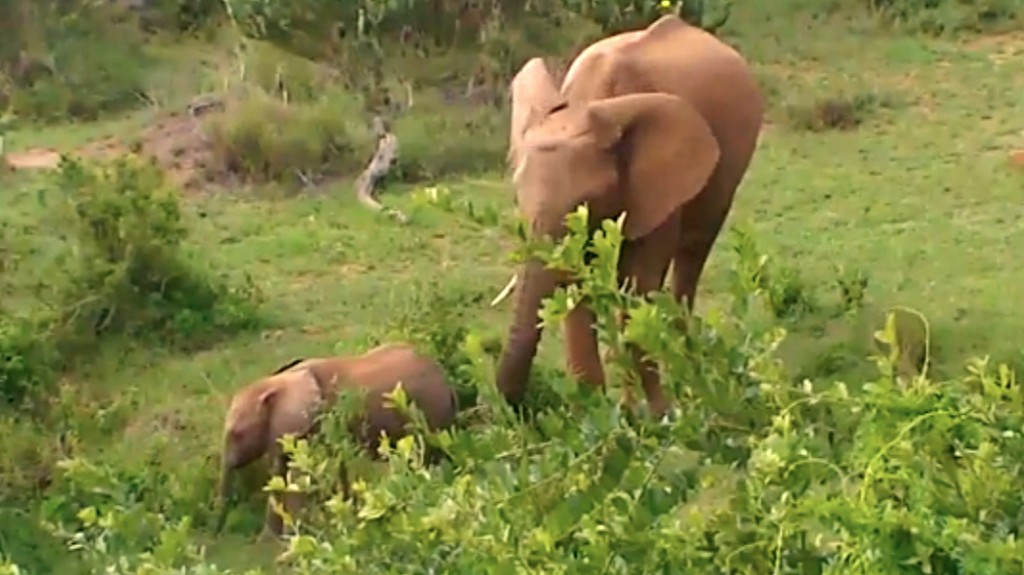A herd of elephants was spotted this week on the Mpala Live Cam. The star of the show was a sprightly baby elephant who stayed close to his mother.
The social structure of elephants is based upon one central unit: the family. An elephant family is led by a matriarch, the eldest female in the group. The family can vary in size from 2 individuals to 45 or more and can bridge 4 generations of related elephants. Families are composed of adult females, calves, and juveniles; male elephants leave their birth family at the age of 14 to join other bulls or remain on their own. – See more at: http://mpalalive.org/field_guide/african_elephant#sthash.wgnMNWYO.dpuf
The social structure of elephants is based upon one central unit: the family. An elephant family is led by a matriarch, the eldest female in the group. The family can vary in size from 2 individuals to 45 or more and can bridge 4 generations of related elephants. Families are composed of adult females, calves, and juveniles; male elephants leave their birth family at the age of 14 to join other bulls or remain on their own. – See more at: http://mpalalive.org/field_guide/african_elephant#sthash.wgnMNWYO.dpuf
The social structure of elephants is based upon one central unit: the family. An elephant family is led by a matriarch, the eldest female in the group. The family can vary in size from 2 individuals to 45 or more and can bridge 4 generations of related elephants. Families are composed of adult females, calves, and juveniles; male elephants leave their birth family at the age of 14 to join other bulls or remain on their own. – See more at: http://mpalalive.org/field_guide/african_elephant#sthash.wgnMNWYO.dpuf
The social structure of elephants is based upon the family unit and led by a matriarch, usually the eldest female in the group. Families can vary in size from 2 individuals to 45 or more with four generations of related elephants living and roaming together including adult females, calves, and juveniles. Male elephants, however, leave their birth family at the age of 14 to live on their own.
These elephants lumbered through the grassland eating leaves and other vegetation. Elephants in general eat a LOT of vegetation; a single individual can consume 300 pounds of grass, roots, leaves, and bark every day. They need these calories to sustain their enormous masses.
Baby elephants stay very close to their mothers and drink their mother’s milk for about 2 years, sometimes longer. At about four months old, they’ll begin eating some plants, but will continue drinking milk for up to ten years. Using their trucks is a bit of a learning process; for a while they’re all thumbs. But by about 1 year of age, baby elephants can manipulate their appendages pretty well, as you’ll see in the full clip below:
The social structure of elephants is based upon one central unit: the family. An elephant family is led by a matriarch, the eldest female in the group. The family can vary in size from 2 individuals to 45 or more and can bridge 4 generations of related elephants. Families are composed of adult females, calves, and juveniles; male elephants leave their birth family at the age of 14 to join other bulls or remain on their own. – See more at: http://mpalalive.org/field_guide/african_elephant#sthash.wgnMNWYO.dpuf
The social structure of elephants is based upon one central unit: the family. An elephant family is led by a matriarch, the eldest female in the group. The family can vary in size from 2 individuals to 45 or more and can bridge 4 generations of related elephants. Families are composed of adult females, calves, and juveniles; male elephants leave their birth family at the age of 14 to join other bulls or remain on their own. – See more at: http://mpalalive.org/field_guide/african_elephant#sthash.wgnMNWYO.dpuf
EXPLORE The Complete – African Lookout Live Camera Experience



